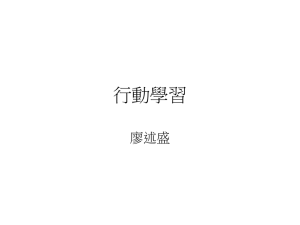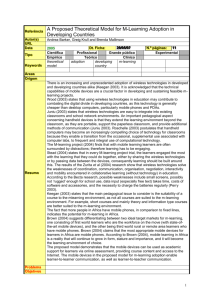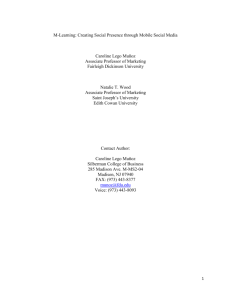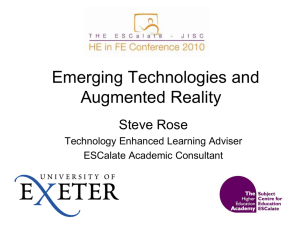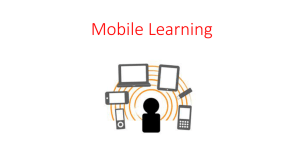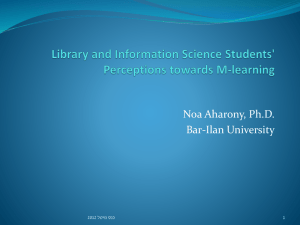Why is m-learning thriving?
advertisement
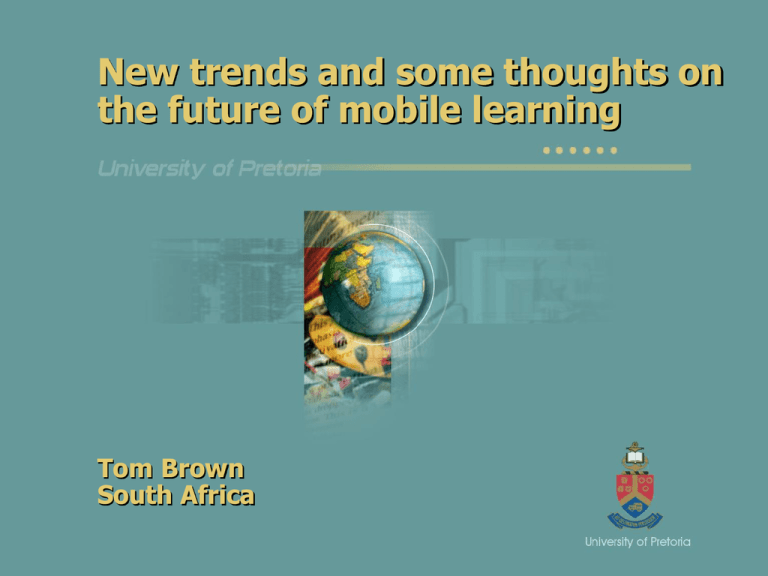
New trends and some thoughts on the future of mobile learning Tom Brown South Africa Introduction The keen adoption of m-learning in educational environments and the number of pilot projects show that m-learning is experiencing exponential growth. Constructivism has been the learning paradigm during the past few decades… And m-learning is thriving in social constructivist learning paradigms. However, ICT developments are impacting educational practice and we will, in future, experience shifts in learning paradigms! • What will new mobile devices look like? • What will new learning paradigms look like? • What will the role of m-learning be in these new learning paradigms? Why is m-learning thriving? Why is m-learning thriving? • “Around 62% of all adults across the major European countries now use a mobile phone, according to the research. • Currently, 41% of European adults use SMS, compared to 30% that use the Internet / email. • SMS is particularly popular in the UK where 49% of adults use it, compared to 39% who are online. • In Germany, 43% of adults use SMS as opposed to 29% of adults who use the Internet/email. In France, 30% use SMS compared to 25% who go online.” Statistics from Gartner (2002) Why is m-learning thriving? • • • • • • “Over 50% of all employees spend up to half of their time outside the office. More than 525 million web-enabled phones will be shipped by 2003. Worldwide mobile commerce market will reach $200 billion by 2004. There will be more than 1 billion wireless internet subscribers worldwide by 2005. Multi-purpose handheld devices (PDA and telephone) will outsell laptop/desktop computers combined by 2005. Most major US companies will either switch to or adopt wireless networks by 2008.” Statistics from Empowering Technologies Incorporated cited by Keegan (2003) Why is m-learning thriving? • Desmond Keegan recently (2003) published his latest book called: ‘The Future of Learning: From eLearning to mLearning.’ In chapter four of his book, Keegan presents and analyses no less than 30 m-learning initiatives across the globe in 2001. • NKI Distance Education in Norway has 400 elearning courses. During 2003 and 2004 it announced that it had made available mobile learning versions of all its 400 courses. This represents a massive introduction of mobile learning. Why is m-learning thriving? • Exponential growth in wireless networks, services and devices • Learners are continually demanding more mobile services and experiences • Greater personalisation, flexibility and mobility • Improved access anywhere, anytime • Fills small gaps of time with useful learning events (“stolen moments for learning” David Metcalf) • M-learning enhances collaborative, co-operative and active learning • Mobile communication devices provide opportunities for the optimising of interaction and communication between lecturers and learners, among learners and between members of COPs. Why is m-learning thriving? “For the first time in ICT history, we have the right time, the right place and the right idea to have a huge impact on education: handheld computing.” Soloway (2003) Why is m-learning thriving? “The mixing of distance learning with mobile telephony to produce mLearning will provide the future of learning.” Keegan (2003) Why is m-learning thriving? “By 2006, data network access from personally owned mobile devices will be the leading problem facing higher education IT managers.” Gartner (2004) Why is m-learning thriving? “The mobile revolution is finally here. Wherever one looks, the evidence of mobile penetration and adoption is irrefutable: cell phones, PDAs, MP3 players, portable game devices, handhelds, tablets and laptops abound. No demographic is immune from this phenomenon. From toddlers to seniors, people are increasingly connected and are digitally communicating with each other in ways that would have been impossible to imagine only a few years ago.” Wagner (2005) What is the relation between m-learning and e-learning? m-learning vs e-learning • E-learning is the macro concept that includes online and mobile learning environments. • M-learning is a subset of e-learning. • E-learning is in turn a subset of distance learning, which is in turn a subset of flexible learning. “M-learning is e-learning through mobile computational devices” Quin (2001) m-learning vs e-learning Flexible Learning Contact Learning (residential/face-to-face) Distance Learning E-learning Online Learning M-learning Paper-based Distance Learning Diagram 1: The subsets of flexible learning (Brown, 2004) Approaches to m-learning Approaches to the use of m-learning technologies Content approach Communication approach Focus on communication “Communication is the source from which m-learning emerges. ” Nyiri (2002) Current m-learning activities and projects Current activities and projects The use of mobile phones and SMS: Administrative learning support: • Bulk SMS for administrative information • Access to examination and test marks via mobile service number or m-portal • Access to financial statements and registration data via mobile service number or m-portal Academic learning support: • Communication and interaction (bulk SMS / IVR) • Assessment (MCQs / Quizzes) • Feedback on assignments and tasks • Motivational and instructional messages Current activities and projects • • • • • Integration of m-learning with established elearning environments: M-portals and SMS-gateways (SMS-portal integrated with the LMS/LCMS [e.g. WebCT]) Mobile tutoring Mobile blogging M-assessment (e-assessment on mobile devices) Collaborative learning, discussion groups Wireless environments: • Pilot wireless classrooms • Hot spots and wireless LANs on campus Current activities and projects The use of PDAs, smartphones and Pocket PCs: • Classroom “tools” (note taking, scheduling, etc) • Beaming (via bluetooth) in classrooms (sharing notes, handing in assignments, etc) • Assessment: assessing performance and providing automated results and feedback • Coursework, scheduling and assignments in wirless environments • JIT on-the-spot information for field workers, brokers, salespersons, etc Current activities and projects • Language learning through SMS • JIT on-the-spot (e.g. medical) resources on PDA • ME-learning (personalised, appreciation for own learning process) • Mobile composing (music composition on PDAs) • Contextual and locational awareness (e.g. at museums) • Mobile tutoring • Mobile blogging (moblogging) • Courseware and multimedia on PDAs (including distribution and streaming) • Assessment • Experiential learning and fieldwork • Collaborative learning, discussion groups Noteable EU-funded projects • MOBIlearn (context awareness, adaptive human interfaces, mLCMS, mobile media delivery, collaborative learning, etc) • M-Learning Project (platforms & systems, learning materials for small screens [various devices], collaborative tools, etc) • Ericsson Leonardo Da Vinci project (mLCMS, courses and courseware, tools, etc) Latest and future developments • • • • • • • • • • Moblogging (mobile blogging) Instant messaging (IM) Wireless Google Collapse-to-Zoom and Popouts Ambient technology and intelligence Personalised learning with dynamic adaptation of learning resources to individual preferences Text to speech & speech recognition for mobile devices Multi-user applications and resources Multi-technology interaction Podcasting (broadcasting of audio to iPods) What will m-learning environments look like in 2010? 2010 envisaged • Wireless is “big” and mobile devices are “small” • Ambient technology and intelligence • Always-on wireless connections and ubiquitous computing • Wearable mobile technologies • Bio-informatics a commercial reality • New methods and approaches to learning and collaborating with ICT • Personalised learning with dynamic adaptation of learning resources to individual preferences • From courseware to performanceware • m-LMSs and m-LCMSs • Platforms supporting multi-user interaction on software, applications and equipment 2010 envisaged 2010 envisaged 2010 envisaged 2010 envisaged 2010 envisaged 2010 envisaged 2010 envisaged 2010 envisaged 1GHz 20GB hard drive 256MB DDR RAM 800 x 480 W-VGA 5" display 8mb video RAM Bluetooth 802.11b wireless 4-pin FireWire (1394) USB 1.1 2010 envisaged What will future learning paradigms look like? Example of EU plans The European Union’s aims for 2010: From PC centered to ambient intelligence: • personalised and for all users • surrounding environment is the interface • technology is almost invisible • infinite bandwidth and full multimedia • almost 100% online community Focus on maximizing the learning process and its impact Oliveira (2003) Example of EU plans The European Union’s aims for 2010: Innovations in learning: • personalised and adaptive learning • dynamic mentoring systems • integrating experienced based learning into the classroom • research on new methods and new approaches to learning with ICT Oliveira (2003) Example of EU plans The European Union’s aims for 2010: Learning resources: • dynamically adapt learning resources to individual needs and preferences • digital learning resources and professional learning for work • platforms supporting collaborative learning Access: • mobile learning and interface technologies Oliveira (2003) Supported inquiry • Supported inquiry (guided research) [my version: facilitated and supported inquiry] • From courseware to performanceware ''Inquiry into authentic questions generated from student experiences is the central strategy for teaching'' Soloway (2003) Focus on: • Collaboration and discourse • Learning in context and task-sensitive • ICT an integrated part of learning process Rise of the knowledge economy • According to Gartner (2003) the new knowledge economy is merely in its emerging stages. The knowledge economy will only reach maturity from 2010 onwards. Rise of the knowledge economy Rise of the knowledge economy • According to Gartner (2003) the new knowledge economy is merely in its emerging stages. The knowledge economy will only reach maturity from 2010 onwards. • A doubling of the world’s knowledge (Bontis, 2002): 1930 every 30 years 1970 every 7 years 2010 every 11 hours Rise of the knowledge economy • According to Gartner (2003) the new knowledge economy is merely in its emerging stages. The knowledge economy will only reach maturity from 2010 onwards. • A doubling of the world’s knowledge (Bontis, 2002): 1930 every 30 years 1970 every 7 years 2010 every 11 hours • We already experience enormous challenges in coping with the current overflow of available information. It is difficult to imagine what it will be like when the knowledge economy is in its prime... Future learning paradigms Paradigm shifts? knowledge adoption knowledge production information gathering information generation constructivism social constructivism teaching learning facilitation Beyond constructivism? Exploring and anticipating learning paradigms beyond constructivism Past Present Knowledge Adoption Knowledge Production learn = study learn = research rote learning active and productive learning behaviourism constructivism Knowle learn = e navigating, e problem solvi navigation social constructivism teaching / instruction learning facilitation mentori guided research / supported inquiry The teacher is the primary source of knowledge [source of the WHAT] The teacher is one of the sources of knowledge [source of the WHAT and assisting with the HOW] Knowledge creation is for some elites and knowledge is already in place Knowledge creation is the central issue The focus of learning is on gaining knowledge The focus of learning is on creating knowledge The teacher is competencies [source of the Knowledge cre issue. The cen to navigate wit knowledge exp The focus of le in the ocean of Beyond constructivism? Exploring and anticipating learning paradigms beyond constructivism Past Present Knowledge Adoption Knowledge Production learn = study learn = research rote learning active and productive learning behaviourism constructivism ? ? Knowle learn = e navigating, e problem solvi navigation social constructivism teaching / instruction learning facilitation mentori guided research / supported inquiry The teacher is the primary source of knowledge [source of the WHAT] The teacher is one of the sources of knowledge [source of the WHAT and assisting with the HOW] Knowledge creation is for some elites and knowledge is already in place Knowledge creation is the central issue The focus of learning is on gaining knowledge The focus of learning is on creating knowledge The teacher is competencies [source of the Knowledge cre issue. The cen to navigate wit knowledge exp The focus of le in the ocean of Beyond constructivism? Exploring and anticipating learning paradigms beyond constructivism Past Present Future Knowledge Adoption Knowledge Production Knowledge Navigation learn = study learn = research learn = evaluate / navigate rote learning active and productive learning navigating, evaulating, integrating, problem solving and communicating behaviourism constructivism navigationism / evaluationism social constructivism teaching / instruction learning facilitation mentoring and coaching guided research / supported inquiry The teacher is the primary source of knowledge [source of the WHAT] The teacher is one of the sources of knowledge [source of the WHAT and assisting with the HOW] Knowledge creation is for some elites and knowledge is already in place Knowledge creation is the central issue The focus of learning is on gaining knowledge The focus of learning is on creating knowledge The teacher is the source of skills and competencies required to navigate [source of the HOW] Knowledge creation is a side/implied issue. The central issue is to be able to navigate within the enormous knowledge explosion The focus of learning is on navigating in the ocean of available knowledge Beyond constructivism? Exploring and anticipating learning paradigms beyond constructivism Past Present Future Knowledge Adoption Knowledge Production Knowledge Navigation learn = study learn = research learn = evaluate / navigate rote learning active and productive learning navigating, evaulating, integrating, problem solving and communicating behaviourism constructivism navigationism / evaluationism social constructivism teaching / instruction learning facilitation mentoring and coaching guided research / supported inquiry The teacher is the primary source of knowledge [source of the WHAT] The teacher is one of the sources of knowledge [source of the WHAT and assisting with the HOW] Knowledge creation is for some elites and knowledge is already in place Knowledge creation is the central issue The focus of learning is on gaining knowledge The focus of learning is on creating knowledge The teacher is the source of skills and competencies required to navigate [source of the HOW] Knowledge creation is a side/implied issue. The central issue is to be able to navigate within the enormous knowledge explosion The focus of learning is on navigating in the ocean of available knowledge Paradigm shifts in education Past Present Future knowledge adoption knowledge production knowledge navigation behaviourism objectivism cognitivism constructivism navigationism instruction learning facilitation coaching and mentoring information gathering information generation information navigation knowledge provision knowledge management knowledge facilitation Paradigm shifts in education Past Present Future knowledge adoption knowledge production knowledge navigation behaviourism objectivism cognitivism constructivism navigationism instruction learning facilitation coaching and mentoring information gathering information generation information navigation knowledge provision knowledge management knowledge facilitation Paradigm shifts in education Past Present Future knowledge adoption knowledge production knowledge navigation behaviourism objectivism cognitivism constructivism navigationism instruction learning facilitation coaching and mentoring information gathering information generation information navigation knowledge provision knowledge management knowledge facilitation Role Changes in education Role Player Past Present Future Knowledge Adoption Era Knowledge Production Era Knowledge Navigation Era Learner knowledge adoption knowledge production knowledge navigation Teacher instruction learning facilitation coaching and mentoring design of learning facilitation and learning activities re-/configuration of knowledge design of coaching and navigation activities configuration of navigation tools information configuration knowledge management information facilitation knowledge facilitation design of Instructional instruction Designer reduction of content Information Specialist information gathering and provision knowledge provision Role Changes in education Role Player Past Present Future Knowledge Adoption Era Knowledge Production Era Knowledge Navigation Era Learner knowledge adoption knowledge production knowledge navigation Teacher instruction learning facilitation coaching and mentoring design of learning facilitation and learning activities re-/configuration of knowledge design of coaching and navigation activities configuration of navigation tools information configuration knowledge management information facilitation knowledge facilitation design of Instructional instruction Designer reduction of content Information Specialist information gathering and provision knowledge provision Role Changes in education Role Player Past Present Future Knowledge Adoption Era Knowledge Production Era Knowledge Navigation Era Learner knowledge adoption knowledge production knowledge navigation Teacher instruction learning facilitation coaching and mentoring design of learning facilitation and learning activities re-/configuration of knowledge design of coaching and navigation activities configuration of navigation tools information configuration knowledge management information facilitation knowledge facilitation design of Instructional instruction Designer reduction of content Information Specialist information gathering and provision knowledge provision Future learning paradigms “I believe that the real literacy of tomorrow will have more to do with being able to be your own private, personal reference librarian, one that knows how to navigate through the incredible, confusing, complex information spaces and feel comfortable and located in doing that. So navigation will be a new form of literacy if not the main form of literacy for the 21st century.” Brown (1999) The role of m-learning in future learning paradigms The future role of mobile devices • • • • • • • • In general: Access to information and knowledge Ambient connectivity to people and resources Communication and interaction Navigation tools to deal with the abundance of information and knowledge in the knowledge era In education: NOT the delivery of content per se Communication, collaborative learning and learning (navigationism) support Tools to improve effectiveness and efficiency Navigation tools to optimise learning activities Current approaches to m-learning Approaches to the use of m-learning technologies Content approach Communication approach Paper vs PDA content Why (contemporary) learners prefer content on paper rather than on a PDA: • Internal memory is limited and sometimes causes the PDA to be too slow. • Making notes on the PDAs is an effort and the keyboard is too small. • Reading a document requires too much scrolling. • Pictures in the .doc or .pdf documents are not always of high quality. • It takes too much effort and more time to read documents on a PDA. • A printed version of the documents is easier to use. Wentzel, P. et al (2005) Could be a different story when future sophisticated PDAs offer similar functionalities as laptops or PCs. Future approaches to m-learning Approaches to the use of m-learning technologies ‘Navigation’ approach Communication approach The future of m-learning “Whether we like it or not, whether we are ready for it or not, mobile learning represents the next step in a long tradition of technology mediated learning. It will feature new strategies, practices, tools, applications, and resources to realize the promise of ubiquitous, pervasive, personal, and connected learning. It responds to the ondemand learning interests of connected citizens in an information-centric world.” Wagner (2005) Our challenges A navigationism paradigm • Institutions should move away from providing content per se to learners. We should focus on how to enable learners to find, identify, manipulate and evaluate existing knowledge, to integrate this knowledge in their world of work and life, to solve problems and to communicate this knowledge to others. • Teachers and educators should become the source of HOW to navigate in the ocean of available information and knowledge. We should become coaches within the knowledge economy. Brown (2005) Challenge 1 Our first challenge as educators… …is to design and develop appropriate learning environments, based on sound pedagogical / didactical principles that will ensure the optimisation of learning in new learning environments. Challenge 2 Our second challenge as m-learning and educational technology experts… …is to keep abreast of developments in learning theory and to identify and anticipate shifts in learning paradigms to be able to adopt and adapt educational technologies that will ensure the optimisation of learning in the knowledge era. Thank you References Bontis, N. (2002). The rising star of the Chief Knowledge Officer. Ivey Business Journal, March/April 2002: 20 – 25. Brown, J.S. (1999). Learning, Working & Playing in the Digital Age. Paper delivered at the 1999 Conference on Higher Education of the American Association for Higher Education, March 1999, Washington, USA. Brown, T.H. (2004) The role of m-learning in the future of elearning in Africa? In Distance Education and Technology: Issues and Practice. Hong Kong. Brown, T.H. (2005) Beyond constructivism: Exploring future learning paradigms. In: Education Today, issue 2 of 2005, Aries Publishing Company, Thames, New Zealand. Gartner (2002). SMS bigger than email in Europe. In Nua Internet Surveys, November 11, 2002. Cited in TAD Consortium Dec 2002 Information Update No. 4, Telematics for African Development, Johannesburg, South Africa. References Gartner (2003). Emerging Technology Scenario. Paper delivered by Gartner analyst Nick Jones at the Gartner Symposium and ITxpo, 4 – 6 August 2003, Cape Town, South Africa. Gartner (2004) Predicts 2005: Higher Education Evolves, Gartner Inc, Stamford, USA. Keegan, D. (2003). The future of learning: From eLearning to mLearning. Hagen: Fernstudienforchung, Germany. Moore G.A. (1991) Crossing the chasm. Marketing and selling high tech products to mainstream customers. Harper Business. Nyiri, K. (2002). Towards a philosophy of m-learning. Paper delivered at the IEEE international workshop on wireless and mobile technologies in education. August 29-30, 2002, Växjö University, Sweden. References Oliveira, C. (2003). Towards a knowledge society. Keynote address delivered at the IEEE international conference on advanced learning technologies (ICALT). July 2003, Athens, Greece. Quin, C. (2001). mLearning: Mobile, Wireless, In-Your-Pocket Learning. LiNE Zine [On-line], Fall 2002. Soloway, E. (2003). Handheld computing: Right time, right place, right idea. Paper delivered at the IEEE international conference on advanced learning technologies (ICALT). July 2003, Athens, Greece. Wagner, E.D. (2005) Enabling Mobile Learning. EDUCAUSE Review, vol. 40, no. 3 (May/June 2005): 40–53. Wentzel, P. et al (2005) Using Mobile Technology to Enhance Students’ Educational Experiences. Case Study from the EDUCAUSE Center for Applied Research, Boulder, Colorado, USA. The adoption curve The technology adoption lifecycle (Moore, 1991)

